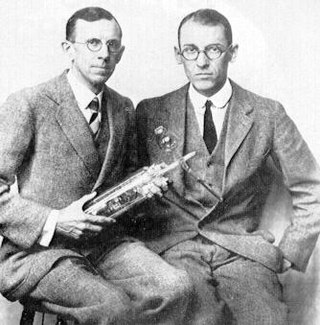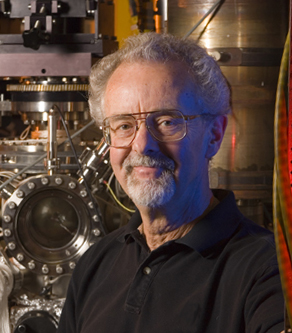Related Research Articles
Clinton Joseph Davisson was an American physicist who won the 1937 Nobel Prize in Physics for his discovery of electron diffraction in the famous Davisson–Germer experiment. Davisson shared the Nobel Prize with George Paget Thomson, who independently discovered electron diffraction at about the same time as Davisson.

The Davisson–Germer experiment was a 1923–1927 experiment by Clinton Davisson and Lester Germer at Western Electric, in which electrons, scattered by the surface of a crystal of nickel metal, displayed a diffraction pattern. This confirmed the hypothesis, advanced by Louis de Broglie in 1924, of wave-particle duality, and also the wave mechanics approach of the Schrödinger equation. It was an experimental milestone in the creation of quantum mechanics.

John Lewis "Jan" Hall is an American physicist, and Nobel laureate in physics. He shared the 2005 Nobel Prize in Physics with Theodor W. Hänsch and Roy Glauber for his work in precision spectroscopy.
Joachim Stöhr is a physicist and professor emeritus of the Photon Science Department of Stanford University. His research has focused on the development of X-ray and synchrotron radiation techniques and their applications in different scientific fields with emphasis on surface science and magnetism. During his career he also held several scientific leadership positions, such as the director of the Stanford Synchrotron Radiation Laboratory (SSRL) and he was the founding director of the Linac Coherent Light Source (LCLS), the world's first x-ray free electron laser.

Alexander Dalgarno FRS was a British physicist who was a Phillips Professor of Astronomy at Harvard University.

Earl Ward Plummer was an American physicist. His main contributions were in surface physics of metals. Plummer was a professor of physics at Louisiana State University, University of Pennsylvania and the University of Tennessee - Knoxville.
The Davisson–Germer Prize in Atomic or Surface Physics is an annual prize that has been awarded by the American Physical Society since 1965. The recipient is chosen for "outstanding work in atomic physics or surface physics". The prize is named after Clinton Davisson and Lester Germer, who first measured electron diffraction, and as of 2007 it is valued at $5,000.
Robert Gomer was an Austrian scientist known for his research on field electron emission and field ionization, and his role as an adviser to the United States government.
Max Gunter Lagally is Erwin W. Mueller Professor and Bascom Professor of Surface Science at the University of Wisconsin–Madison.
Steven Gwon Sheng Louie is a computational condensed-matter physicist. He is a professor of physics at the University of California, Berkeley and senior faculty scientist in the Materials Sciences Division at Lawrence Berkeley National Laboratory, where his research focuses on nanoscience. He is also scientific director of the Theory of Nanostructured Materials Facility at the Molecular Foundry.
Paul Bruce Corkum is a Canadian physicist specializing in attosecond physics and laser science. He holds a joint University of Ottawa–NRC chair in attosecond photonics. He also holds academic positions at Texas A&M University and the University of New Mexico. Corkum is both a theorist and an experimentalist.

David Jeffery Wineland is an American physicist at the Physical Measurement Laboratory of the National Institute of Standards and Technology (NIST). His most notable contributions include the laser cooling of trapped ions and the use of ions for quantum-computing operations. He received the 2012 Nobel Prize in Physics, jointly with Serge Haroche, for "ground-breaking experimental methods that enable measuring and manipulation of individual quantum systems."
Homer Dupre Hagstrum was an American physicist who specialized in surface physics.

Philip H. Bucksbaum is an American atomic physicist, the Marguerite Blake Wilbur Professor in Natural Science in the Departments of Physics, Applied Physics, and Photon Science at Stanford University and the SLAC National Accelerator Laboratory. He also directs the Stanford PULSE Institute.

Anne Geneviève L'Huillier is a French physicist. She is a professor of atomic physics at Lund University in Sweden.
Olga Anatolevna Kocharovskaya is a distinguished professor of physics at Texas A&M University, known for her contributions to laser physics, quantum optics and gamma ray modulation.
Chris H. Greene is an American physicist and the Albert Overhauser Distinguished Professor of Physics and Astronomy at Purdue University. He was elected a member of the National Academy of Sciences in 2019.
Randall M. Feenstra is a Canadian physicist. He completed a bachelor's degree in engineering physics at the University of British Columbia in 1978, followed by his master's and doctorate in applied physics at the California Institute of Technology. From 1982 to 1995 he was a research staff member at the IBM Thomas J. Watson Research Center in Yorktown Heights, New York. Since 1995, he has taught at Carnegie Mellon University, where he conducts research in semiconductors.
David S. Weiss is an American physicist.
References
- ↑ Buckley, Christine (January 27, 2014), "Laser Physicist Nora Berrah Joins UConn Faculty", UConn Today
- ↑ New Physics Head Brings World-Class Science and Advocacy, University of Connecticut College of Liberal Arts and Sciences, January 21, 2014, archived from the original on 2014-02-08, retrieved 2017-10-06
- ↑ APS Fellow Archive, American Physical Society, retrieved 2017-10-06
- ↑ Davisson-Germer Prize in Atomic or Surface Physics Recipient: Nora Berrah, American Physical Society, retrieved 2017-10-06
- ↑ "New 2019 Academy Members Announced". American Academy of Arts and Sciences. April 17, 2019.
- ↑ "National Academy of Sciences Elects Members and International Members". www.nasonline.org. 30 April 2024. Retrieved 12 May 2024.